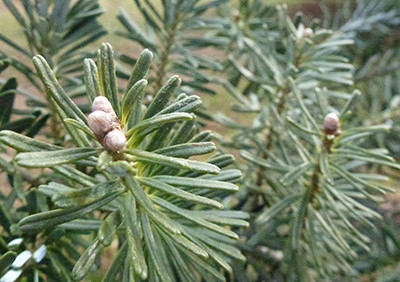
Plants of the Week: February 13
The Korean fir is a neatly branched, dense, conical evergreen with an interesting accent making it irresistible to the eye. Toward the ends of the branches, the needles curve upward to reveal a silver, dual-striped adaxial surface giving the impression of reflected light. This white underside is caused by a dense distribution of stomata (pores for gas exchange necessary for photosynthesis). This effect grants a bright accent against the standard green conical habit. The specific epithet comes from the species nativity to the mountains of South Korea. However a specimen can be found much closer to home, next to Beardsley Hall in the John W. Nason Garden. Photo credit: J. Bickel
The Theresa Lang Garden of Fragrance, located in the courtyard of Clothier Hall, is home to many interesting and fragrant plants. There is a specimen of Elaeagnus pungens espaliered against the south wall of Clothier on the north side of the garden. Though originally chosen for the site due to its small, highly fragrant flowers that bloom in October-November, I found it especially interesting in February due to its coriaceous, spotted leaves and scaled branch tips. The espalier makes it easy to see lots of new shoots at eye level, which are covered in a fine, tan, dust-like scale covering. The evergreen leaves are wavy along the margins subtly revealing the silver undersides. The tops are dappled with small silver spots. Photo credit: J. Bickel
Hamamelis vernalis ‘Kohankie Red’
There are many hybrid and species witchhazels on Swarthmore’s campus; flower colors range from bright yellow-greens to deep purples. Reportedly named for the Henry Kohankie Nursery in Ohio, Hamamelis vernalis ‘Kohankie Red’ is a cultivar with beautiful pinkish-red petals that emerge in fours like ribbon streamers from the small, fragrant flowers. A low growing specimen can be found behind a sizeable stand of Cryptomeria japonica on the south side of Sharples Dining Hall, facing the fraternities. The flowers are visible, though somewhat hidden by the species’ tendency for winter leaf marcesence. Photo credit: J. Bickel








No Comments